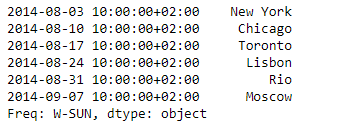Python | Pandas Series.to_latex()
Last Updated :
05 Aug, 2021
Pandas series is a One-dimensional ndarray with axis labels. The labels need not be unique but must be a hashable type. The object supports both integer- and label-based indexing and provides a host of methods for performing operations involving the index.
Pandas Series.to_latex() function render an object to a LaTeX tabular environment table.
Syntax: Series.to_latex(buf=None, columns=None, col_space=None, header=True, index=True, na_rep=’NaN’, formatters=None, float_format=None, sparsify=None, index_names=True, bold_rows=False, column_format=None, longtable=None, escape=None, encoding=None, decimal=’.’, multicolumn=None, multicolumn_format=None, multirow=None)
Parameter :
buf : Buffer to write to. If None, the output is returned as a string.
columns : The subset of columns to write. Writes all columns by default.
col_space : The minimum width of each column.
header : Write out the column names. If a list of strings is given, it is assumed to be aliases for the column names.
index : Write row names (index)
na_rep : Missing data representation.
formatters : Formatter functions to apply to columns’ elements by position or name.
float_format : Format string for floating point numbers.
sparsify : Set to False for a DataFrame with a hierarchical index to print every multi-index key at each row.
Returns : If buf is None, returns the resulting LateX format as a string, otherwise, returns None.
Example #1: Use Series.to_latex() function to render the given series object to LaTeX tabular environment table.
Python3
import pandas as pd
sr = pd.Series(['New York', 'Chicago', 'Toronto', 'Lisbon', 'Rio', 'Moscow'])
didx = pd.DatetimeIndex(start ='2014-08-01 10:00', freq ='W',
periods = 6, tz = 'Europe/Berlin')
sr.index = didx
print(sr)
|
Output :

Now we will use Series.to_latex() function to render the given series object to LaTeX tabular environment table.
Output :

As we can see in the output, the Series.to_latex() function has successfully rendered the given series object to LaTeX tabular environment table.
Example #2: Use Series.to_latex() function to render the given series object to LaTeX tabular environment table.
Python3
import pandas as pd
sr = pd.Series([19.5, 16.8, 22.78, 20.124, 18.1002])
print(sr)
|
Output :

Now we will use Series.to_latex() function to render the given series object to LaTeX tabular environment table.
Output :

As we can see in the output, the Series.to_latex() function has successfully rendered the given series object to LaTeX tabular environment table.
Share your thoughts in the comments
Please Login to comment...